High-performance building envelopes
by brittney_cutler | June 9, 2022 9:00 am
 [1]
[1]By Alejandra Nieto
Deep energy renovations of commercial and multi-unit residential buildings are critical if cities want to tackle their climate emissions on a large scale. Energy renovation could provide up to 55 percent of the greenhouse gas (GHG) emissions reductions needed to meet 2030 targets, aligning cities with a 1.5 C (34.7 F) trajectory. Recently, federal leaders in the U.S. and Canada have announced initiatives that will simultaneously help meet environmental protection targets as well as drive post-pandemic economic recovery.
Presently, renovation rates are one to two percent of the building stock per year, with an average energy use intensity (EUI) reduction of less than 15 percent—to make a significant impact, EUI reductions should be between 30 and 50 percent.1 For these changes to happen, energy codes must add measures to strengthen energy reduction while not raising resultant emissions. Also, policy development around energy retrofits and the adoption of high-performance net-zero buildings must accelerate.
Where codes and policy changes are not enough, project teams and research and development investments require government support to enhance building technologies and materials.
Throughout North America, model energy codes are evolving for higher energy efficiency. Local code adoption and policy development have also strengthened governmental positions on energy reduction targets, adopting building retrofit requirements. For example, in 2019 New York City passed the Climate Mobilization Act, including a series of bills setting specific retrofit requirements and emissions limits (Bill 1253, Local Law 97 of 2019) and additional financing for sustainable retrofits (Bill 12520).
In addition to energy and emissions conservations, building retrofits improve occupant health and comfort. In many cases, existing buildings are poorly insulated, or not insulated at all, and leaky, resulting in excess heat loss and reduced thermal comfort. Mechanical systems are often outdated and inefficient, requiring constant maintenance. In this way, improvements to indoor health and comfort can also be vital drivers for building renewal investment.
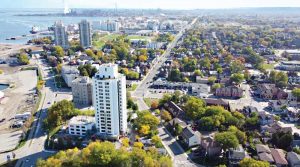 [2]
[2]Where to start?
Existing older buildings will typically have little to no insulation within the envelope, resulting in excess heat loss and increased energy consumption. More importantly, they often do not have any water-resistive and air barriers, making them very leaky and further increasing energy losses. The addition of insulation in exterior walls and roofs, combined with a water-resistive barrier (also acting as part of the air barrier system), is integral to improving building performance, reducing leaks, and creating more comfortable indoor environments.
Material selection for the building envelope is key. Stone wool insulation solutions (batt, semi-rigid, and rigid board for continuous insulation [ci]) are an ideal option for myriad reasons, including the most obvious one—superior performance in improving thermal efficiency. Buildings with stone wool insulation, for example, can see up to 70 percent reduction in heating and cooling costs. Beyond this, the other benefits of specifying stone wool insulation for the building envelope include greater protection from fire, noise, and moisture, each of which can adversely affect the integrity of the building’s structure and long-term durability as well as the health and well-being of its occupants.
All retrofits are not the same
Each building retrofit comes with unique conditions and challenges, requiring a holistic and long-term planning approach to ensure a project achieves its overall goals and specific targets. A comprehensive plan should include auditing the building’s existing conditions, assessing potential energy conservation measures that will be applied, analyzing cost and long-term capital requirements, as well as understanding the social and economic effects on the building occupants (current and future).
Though energy conservation is the primary driver for most large-scale retrofits today, there will be some other consistent criteria that should be considered in different types of commercial retrofits. Many are driven by the needs of the occupants. For example:
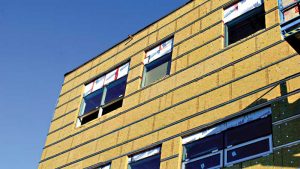 [3]
[3]Office buildings
Evidence shows an office building’s indoor environmental quality (just like office ergonomics) will impact the long-term health and performance of employees; controlling noise with a proper acoustical insulation plan will protect their health and improve productivity.
Schools
Student performance is also closely linked to the building’s indoor environment; receiving natural light during the day will help students sleep better at night, and while colder environments tend to improve concentration, once it exceeds a comfortable level, it will create a negative effect on student performance.
Hotels
A positive guest experience can rely as much on physical comfort and noise control—both in guest rooms as well as common areas—as it does on the building’s aesthetics; if design is an important criterion in a hotel’s retrofit, it need not be sacrificed for the sake of thermal or sound performance by the building envelope; new solutions in stone wool insulation products can satisfy both requirements.
In addition to thermal efficiency and occupant comfort, planning for energy retrofits should also factor in the building’s needs for durability and constructability. One of the critical benefits of retrofitting buildings is these projects can increase their lifespan. The added longevity and durability of an enclosure and the energy savings they create are a way to justify the upfront costs. Assessing the primary water, air and thermal control layers is part of the considerations for a durable enclosure.
It is critical to ensure appropriate drainage and drying measures, and vapor diffusion control considerations are in place, as poorly designed retrofits may lead to unintended moisture damage.
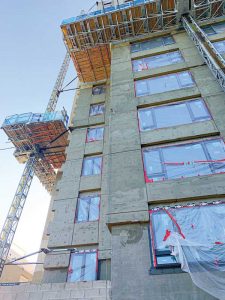 [4]
[4]The constructability of a retrofit relates to the ease with which the retrofit strategy is installed and executed. Likewise, it also encompasses the total cost of implementation and the amount of occupant disturbance. Therefore, upgrading the building enclosure can bring different constructability challenges, depending on the building site and existing condition. The strategies applied will vary and cannot necessarily be applied on all projects in the same manner.
A building envelope is only as good as the sum of its parts
The various applications within the building envelope each have unique requirements that support the building’s goals for thermal efficiency, durability, and constructability.
Exterior wall insulation
Thermal efficiency
Increasingly architects, specifiers, and builders recognize the superior thermal performance of ci on a building’s exterior; it is important to consider the selections for cladding and attachments as they will impact the performance of the ci system. There are numerous generic and proprietary cladding support systems designed for use with exterior insulation and while each system is different, they generally feature continuous framing, intermittent clip and rail, direct fastening with screws, or other engineered systems. Take for example using 102 mm (4 in.) of exterior stone wool with a nominal RSI value of RSI 3.03 (R-17.2). If installed between continuous galvanized steel vertical z-girts, a highly thermal conductive material creating a continuous thermal bridge, the thermal efficiency of the insulation will be around 20 to 40 percent. In comparison, if installed between intermittent stainless-steel clips, the thermal efficiency of the insulation increases from 65 to 85 percent.
Durability
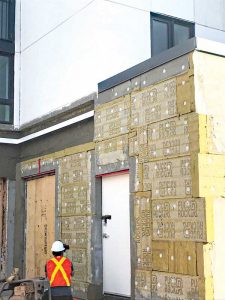 [5]
[5]Upgrades to the exterior side of the enclosure allows for new water control strategies to be applied. The addition of exterior insulation can improve the thermal gradient of a wall assembly by pushing the dew point towards the exterior side of the assembly. However, the ratio of exterior insulation (dependent on climate) and the type of insulation will play a role in the overall performance of this system. For example, when considering assemblies using exterior insulation in cold climates, a vapor-impermeable insulation may reduce the drying potential of the wall assembly, causing moisture-related concerns. This is because in most assemblies, an interior vapor retarder will be used, thus the creation of a double vapor barrier. In these cases, take extreme caution to add enough exterior insulation to avoid these problems. In contrast, if using vapor-permeable exterior insulation such as stone wool, increased drying potential and outward drying is possible as the insulation will not trap moisture within the assembly. Importantly, in addition to the insulation, the other materials within the assembly, especially the exterior water and/or air resistive membrane, also play a key role in driving the vapor performance. In this case, when using a vapor-permeable exterior insulation, the exterior membrane should also be vapor permeable for optimal performance.
Constructability
For exterior insulation, standard attachment strategies such as continuous girts, or clip-and-rail systems, are usually the easiest to install. They do not require new training for contractors, and there is a perceived lower risk of failure. More modern attachment strategies, such as thermally broken clip systems or direct fastening, while gaining traction, may require additional structural analysis and contractor training. Other site considerations are also necessary such as proximity to other buildings, accessibility to the site from occupants (if applicable), and the potential for pedestrian disturbance and increased safety measured in more dense areas.
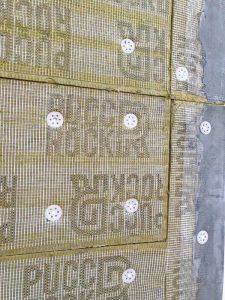 It is also important to note a rainscreen over-cladding system using stone wool insulation can use various substrates, providing versatility and design freedom for architects and designers. Depending on the cladding type and weight, the overall desired insulation performance, and thickness, they can be accommodated with either thermally broken intermittent clip-and-girt systems or directly fastened through the stone wool insulation. Likewise, over-cladding solutions using stone wool insulation provide versatility in design and cladding options along with additional fire resistance. Non-combustible stone wool insulation has a flame spread index and smoke development index of zero. It does not trigger assembly testing, such as ULC S134, the Standard Method of Fire Test of Exterior Wall Assemblies, even near other buildings, such as in dense metropolitan markets.
It is also important to note a rainscreen over-cladding system using stone wool insulation can use various substrates, providing versatility and design freedom for architects and designers. Depending on the cladding type and weight, the overall desired insulation performance, and thickness, they can be accommodated with either thermally broken intermittent clip-and-girt systems or directly fastened through the stone wool insulation. Likewise, over-cladding solutions using stone wool insulation provide versatility in design and cladding options along with additional fire resistance. Non-combustible stone wool insulation has a flame spread index and smoke development index of zero. It does not trigger assembly testing, such as ULC S134, the Standard Method of Fire Test of Exterior Wall Assemblies, even near other buildings, such as in dense metropolitan markets.
Interior wall insulation
Thermal efficiency
Interior insulation strategies can either include direct-fastening insulation, adding insulation between wood or steel studs, or a combination. However, interior insulation strategies do not mitigate large thermal bridges such as floor slabs, and often increases the thermal bridge and potential impacts. To account for these large thermal bridges, consider floor and roof insulation around the walls’ perimeter, although these are not as effective as an exterior insulation solution. When working on the enclosure’s interior side, ensuring continuity of the materials and their transitions becomes more complex due to the intersections with the interior floors, walls, etc.
Durability
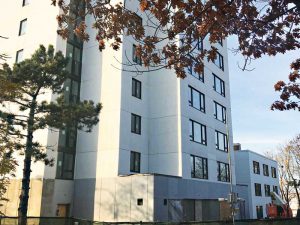 [6]
[6]Interior retrofits are often a solution for buildings with limited lot lines or where the exterior aesthetic requires preservation for historical reasoning or client requests. However, an interior retrofit comes with additional performance and durability considerations due to the insulation’s location and the potential for interstitial condensation. In these cases, airtightness is crucial to reducing the transfer of moist air through the assembly. Even with an interior retrofit strategy, exterior work still may be required; for example, ensuring there are appropriate overhangs and drip edges to limit water exposure, fixing the existing cladding if applicable, or updating windows and doors.
Constructability
Typically, an interior retrofit can be considered a more straightforward installation than exterior retrofits. The additional insulation weight is carried by the internal floor structure and held in place with non-structural elements, prioritizing structural weight as a safety concern. However, interior retrofits will have a level of occupant disturbance. If residents live in the building, there may be associated costs to ensure their health and safety.
Considerations for masonry walls
Masonry walls present unique challenges. Existing masonry buildings are often a target for interior retrofits due to facade preservation requirements. Historically, masonry walls vary in thickness, consisting of multiple wythes (layers) of brick that range in quality—the exterior wythes will be of higher quality than the interior wythes. Masonry walls are heavy and porous, allowing them to store moisture. Since older masonry walls often do not have insulation, the wall’s energy transfer causes them to dry inefficiently. Therefore, adding interior insulation will change the wall assembly’s temperature gradient, which can be detrimental in winter conditions. For example, internal insulation layers will create a sizeable temperature drop, cooling the brick and potentially causing freeze-thaw damage. Also, masonry walls often do not have a dedicated air barrier system and can be very leaky. Therefore, airtightness is vital for the retrofit design, especially since interior air leakage can condense on the cold brick and cause potential moisture concerns and mold on the newly created interior finishes. Similar conditions apply to other mass-type walls such as pre-cast concrete, tilt-up, or concrete masonry unit where there is no existing insulation.
When retrofitting mass walls on the interior with stone wool insulation, it is recommended to be installed in combination with a capillary break between the masonry and insulation, in addition to an interior smart vapor retarder. For example, creating a capillary break using a vapor permeable, liquid-applied, air and water-resistive barrier, or a gap up to 10 mm (0.38 in.) between the insulation and the substrate. For interior vapor control, a smart vapor retarder (a membrane that transitions in vapor permeability depending on the surrounding relative humidity) is best. In this case, it will assist with inward drying when necessary. For airtightness, the water-resistive barrier (WRB) and interior membrane, taped and sealed, can serve as the primary and secondary air barrier system critical to ensure airtightness requirements to limit moisture-related risks.
Challenges with the constructability of interior insulation systems on masonry walls are often design related. The enclosure is usually required to be thinner, to not take up more than necessary interior space. It may require the ability to be easily disassembled without damages to the existing substrate. In addition, the substrate may not always have an even surface in which using an insulation that allows for some compression such as stone wool insulation provides greater flexibility.
Flat roofs
Thermal efficiency
Most existing buildings that are ready for a roof retrofit have insulation levels below current energy standards. Although increasing the thermal performance to current standards may not be necessary when conducting roof renovations, it can be critical for energy savings. Depending on the retrofit strategy, this may be achieved by adding a few additional inches of insulation over the existing roof, or it may require a full re-roof (tear-off). From a thermal efficiency standpoint, different roofing systems will encounter other thermal effects depending on the application, type of insulation, temperature exposures, number of fasteners, and material properties. Insulation boards used in roofing applications may be fastened into place using screws with varying densities and lengths, or adhered. Roof systems are subject to higher and larger temperature fluctuations, meaning their membranes and insulation materials are subject to expansion. For example, foam plastics are at more significant risk to thermal deficiencies caused by gaps and holes caused by thermal expansion and contraction, along with their in-situ climate-dependent thermal performance.
Durability
In some cases, insulations like polyisocyanurate will be susceptible to lower thermal performance at cold temperatures, affecting overall performance, especially in cold climates. To reduce the effects of expansion and contraction, double layers with offset seams are necessary. A design solution to limit the impact of climate-dependent thermal performance and thermal expansion and contraction includes using a dimensionally stable insulation board (such as stone wool) as the second insulation layer or as the system coverboard.
Constructability
In the case of recovery or full re-roof, consider the existing roof’s parapet heights to ensure there is enough space to add the desired thickness of insulation. Installing crickets to modify drainage is a simple solution, mainly when the parapets’ roof edge is low and does not allow for increased depths. Most importantly, the roof’s structural capacity requires engineering evaluation to ensure it can handle the weight of the new or added layers and confirm the existing deck is compliant with structural requirements, determined by a pull-through test.
For roof remediation systems incorporating additional insulation, choices will vary depending on the new membrane type. Adding stone wool insulation in a recovery system helps improve the roof’s overall durability and thermal efficiency if the existing insulation is in poor condition and gaps are evident. Placing a 52 mm (2 in.) layer of rigid stone wool insulation with a total added RSI value of RSI 1.34 (R-7.6) is a cost-effective measure to improve thermal performance, fire safety, and sound attenuation.
In a full re-roof application, the new insulation system can be either full-depth stone wool or a hybrid roof design, incorporating a layer of stone wool insulation over a base layer of polyisocyanurate insulation. This solution can also comply with updated wind load and fire testing requirements. Full re-roofing is optimal for buildings with a high roof-to-wall ratio where most of the heat loss occurs through the top, and there is a favorable cost-benefit to performing this work.
Project spotlight: Ken Soble Tower in Ontario, Canada
The Ken Soble Tower project sought to rehabilitate a post-war apartment building in Hamilton, Ontario, Canada. The building was completely upgraded, inside and out, to achieve Passive House standard. The building overhaul would include nearly every facet of the building from the building envelope, mechanical systems, electrical, plumbing, and safety systems to interior upgrades to its 146 units to support aging in place, accessibility, comfort, and overall improvement of the occupant experience. The cladding design includes a 152-mm (6-in.) thick stone wool exterior insulation and finish system (EIFS) system. Architects chose this EIFS system due to the non-combustibility, the excellent moisture control offered by both the stone wool and the unique, built-in drainage layer cut into the back side of the insulation, as well as the liquid-applied water-resistive barrier used in the EIFS system.
In all, 4645 m2 (50,000 sf) of stone wool insulation was incorporated into the new facade, helping to realize the RSI-6.69 (R-38) effective RSI value required to achieve EnerPHIT Passive house certification, while reducing greenhouse gas emissions by an impressive 94 percent.
- [Image]: https://www.constructionspecifier.com/wp-content/uploads/2022/05/2-flat-roof-toprockdd.jpg
- [Image]: https://www.constructionspecifier.com/wp-content/uploads/2022/05/1-Ken-Soble_Aerial-01_credit-Cordin-Talaba.jpg
- [Image]: https://www.constructionspecifier.com/wp-content/uploads/2022/05/3-Understanding-Advancing-Wall-System.jpg
- [Image]: https://www.constructionspecifier.com/wp-content/uploads/2022/05/4-IMG_1192_credit-ERA-Architects.jpg
- [Image]: https://www.constructionspecifier.com/wp-content/uploads/2022/05/KST-4.jpg
- [Image]: https://www.constructionspecifier.com/wp-content/uploads/2022/05/KST-8.jpg
Source URL: https://www.constructionspecifier.com/high-performance-building-envelopes/
 Alejandra Nieto is a sustainability manager for ROCKWOOL. She is a graduate from the Master of Building Science program at Ryerson University; with a background in construction science and management, and architectural technology from George Brown College. She has experience in design and research of the methods and materials involved in sustainable and energy efficient buildings and systems, and is an active member in multiple American Society of Heating, Refrigerating and Air-Conditioning Engineers (ASHRAE) technical committees.
Alejandra Nieto is a sustainability manager for ROCKWOOL. She is a graduate from the Master of Building Science program at Ryerson University; with a background in construction science and management, and architectural technology from George Brown College. She has experience in design and research of the methods and materials involved in sustainable and energy efficient buildings and systems, and is an active member in multiple American Society of Heating, Refrigerating and Air-Conditioning Engineers (ASHRAE) technical committees.